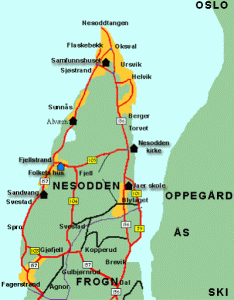By: Nora Hafsteen and Ada Rydhagen
Right now, we’re working on the project “water” in school. Our group got the assignment to find out about our drinking water. In this article you’ll learn about that.
To find out more about this, we had to get some answers about;
- where we get our drinking water from,
- who transports our drinking water,
- how the population here on Nesodden can be sure that our drinking water is clean,
- where the water becomes clean,
- what kind of obstacles you could face against clean water and
- what kind of process the water goes through.
We’ve contacted someone from our municipality to get the answers to this. We’ve also done some research online and found out even more through those sources. Now we’re going to take a closer watch on some of the information we got from the interview with Reidun Isachsen, who is working with our drinking water in our municipality.
Where do we get our drinking water from?

Nesodden’s population get their water from either their own wells or from three municipal waterworks. The main source to the drinking water is Blekslitjern and consists of surface water. The two other water sources we have is smaller and consists of groundwater. Nesodden has also added a waterpipe from a place called Bærum to Nesodden (where we live) as a backup plan. This waterpipe runs along the bottom of the fjord and gives water to the main watersystem, for those who don’t have their own well. This makes us have double securing, so if something happens, we will always have drinking water.
Who transports our drinking water?
For the water to go into our faucets, it has to go through some waterpipes. For it to come out of our faucets, they use pumps to make pressure. We also have elevated basins a lot of places. If we would need some reserve water, these elevated basins are big water reservoirs that lays high in the terrain and is enough for several days.
How does the water become clean?
The water is purified in the water treatment plants that are adjacent to the water sources. It is so-called full purification, with the addition of chemicals to make particles of any contaminants which are subsequently removed in sand filters. In addition, the water is disinfected with both chlorine and UV radiation to remove any bacteria and parasites. This cleansing process fails to remove smell and taste, so for some periods the water may taste a little murky.
What kind of obstacles can you face on the way to clean drinking water?
Obstacles on the way to clean drinking water can be that the raw water itself is polluted or that the treatment of the water doesn’t work in an optimal way. It’s made strict claims about protection of the raw water sources and it is done careful follow-ups in the water treatment plants. This is both done by operating personnel who daily works at the environmental control, camera surveillance of parameters and tests of the water around the waterpipes, before and after cleaning of the water.
Sources:
https://www.nesodden.kommune.no/siste-nytt/det-kommunale-drikkevannet-i-blekslitjern.183786.aspx
Interview with Reidun Isachsen
Thank you for reading our article!
